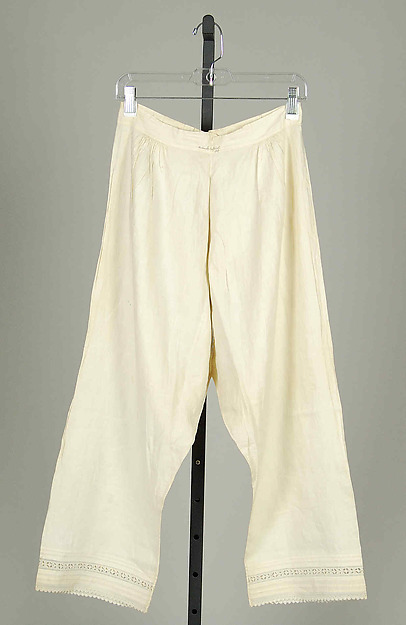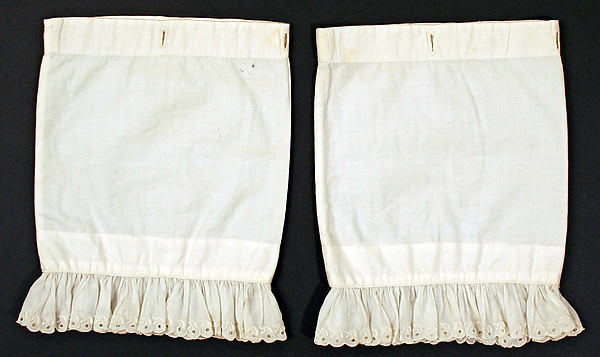"...those comfortable garments we have borrowed from the other sex, and which we all wear, and none of us talk about."
-The Welcome Guest, 1860
 |
| Drawers, from Der Bazar 1865 |
The Workwoman's Guide (1838) describes women's drawers as "two separate legs sewn into a band, which is made to button before or behind, at pleasure". Drawers fit loosely, and may fasten at the front or back, with buttons, tapes, or drawstrings. For adult women, the center seam is left open--the loose fabric covers everything, while allowing one to use the necessary without removing many layers of clothing. Those unconvinced should read Mrs. Clark's cautionary tale.
 |
| Linen drawers with self-fabric tucks, ruffle, and small lace edge. 1860s |
 |
| Cotton drawers with whitework. 1850s |
 |
| Peterson's 1858: pattern for child's drawers |
 |
| Wool drawers with braidwork hem. Though intended for a girl age 7-9, they have an open center seam and back tie. The front button hole may be used to fasten the drawers to a pair of stays. |
In reenactment circles, one may hear drawers called "bloomers", "pantaloons", "pantalets", etc. Here's what I've been able to uncover of period terms and definitions:
The Dictionary of the English Language by A. J. Cooley (1861) defines pantalets as "loose drawers worn by females and children", drawers as "a kind of light under-breeches", and pantaloon as " garment embr[acing] breeches and stockings in one piece; an old man or buffon dressed in pantaloons, one of the ch. characters in pantomines; a kind of trousers fitting closely about the ankles."
Drawers: A bifurcated undergarment, worn by men, women, and children with some differences of cut. They are usually made of washable white cotton or linen, with warmer versions are of red or white wool flannel. When worn by children in short dresses, the lower edge may sometimes be visible (as with pantalets).
"Ladies and gentlemen wear drawers, now, at all seasons; very thin ones in summer and thicker, or woolen over linen or cotton in winter. Ladies wear them for protection from dust, and to avoid accidental exposures; while gentlemen require them to protect their outer clothing from perspiration, and their skins from the roughness of kerseymere." --The Illustrated Manners Book, 1855
Pantalets/Pantalettes: Long, white cotton (or linen) pants or leggings with decorative bottom edges that cover the leg below the skirt hem, and are meant to be visible. In the 1830s, these are ubiquitous for children's wear; even so, except for two school uniform references in 1838, I've seen no mention of girls over 12 wearing them, and only the occasional derogatory remark to suggest adults wearing pantalets (such as this 1842 reference to an older woman making herself ridiculous while attempting to look young). An 1845 story mentions "that [dress] in which I first felt myself a woman--that is, when I first discarded pantalettes". Of the five mentions of "pantalettes"in Arthur's Home Magazine (1857), two are specifically for a "small girl", two for a 10-year-old, and one for a boy still in dresses. Numerous sources in the 1860s use "pantalets" as a shorthand for childhood.
 |
| Pantalets, 1850-55. |
 |
| Pantalets, c. 1838 |
| The Bellelli Family by E. Degas, c.1858-62 |
| Lewis G. Thompson Family by H. Rockwell, c. 1842-5 |
Pantaloons: Sometimes confused with pantalets in the period. As noted above, a breech/stocking combination which has become stereotypical by the mid-19th century. Also, close-fitting trousers. The word from which "pants" is a derived.
Trousers/Trowsers: Outer garment covering the lower limbs from "the waist to the knee or the ankle" (The Imperial Dictionary, 1861); universally worn by men and by boys over the approximate age of five. Adopted by some female "dress reform" advocates in conjunction with a shortened skirt. On page 53, The Workwoman's Guide (1838) uses "trousers" to describe the leg portion of garment comprising drawers and a "body" (bodice). It also features a girls' "Turkish Trouser" pattern which seems to be full pantalets gathered at the ankle.
Bloomer: A derisive name for dress reform advocates or women perceived as unfeminine. The "bloomer costume" (also known as "reform dress" or the "American costume") is the dress reformers' new style of clothes: a knee to mid-calf length dress worn over matching pants or trousers. The "Turkish Trowser" (gathered at the ankle) style is especially associated with dress reformers, though some favored a plain pant leg; despite modern usage, I've found no period reference to the trouser portion of the ensemble specifically being called "bloomers", though the shortened skirt, or the whole outfit may be thus named.
In short, "drawers" are an undergarment, occasionally also called trousers. Pants, pantaloons, and trousers all describe male outer garments. Pantalets are intentionally-visible underwear worn by young girls and very young boys; sometimes (rarely) the term refers to women's drawers. Bloomers are the entire short-dress-and-trouser ensemble worn by some women in the 1850s and occasionally into the 1860s.
Trousers/Trowsers: Outer garment covering the lower limbs from "the waist to the knee or the ankle" (The Imperial Dictionary, 1861); universally worn by men and by boys over the approximate age of five. Adopted by some female "dress reform" advocates in conjunction with a shortened skirt. On page 53, The Workwoman's Guide (1838) uses "trousers" to describe the leg portion of garment comprising drawers and a "body" (bodice). It also features a girls' "Turkish Trouser" pattern which seems to be full pantalets gathered at the ankle.
 |
| "Skirt of black velvet, sufficient short to show the edges of the worked trousers." Frank Leslie's New York Journal (1857) |
In short, "drawers" are an undergarment, occasionally also called trousers. Pants, pantaloons, and trousers all describe male outer garments. Pantalets are intentionally-visible underwear worn by young girls and very young boys; sometimes (rarely) the term refers to women's drawers. Bloomers are the entire short-dress-and-trouser ensemble worn by some women in the 1850s and occasionally into the 1860s.


No comments:
Post a Comment